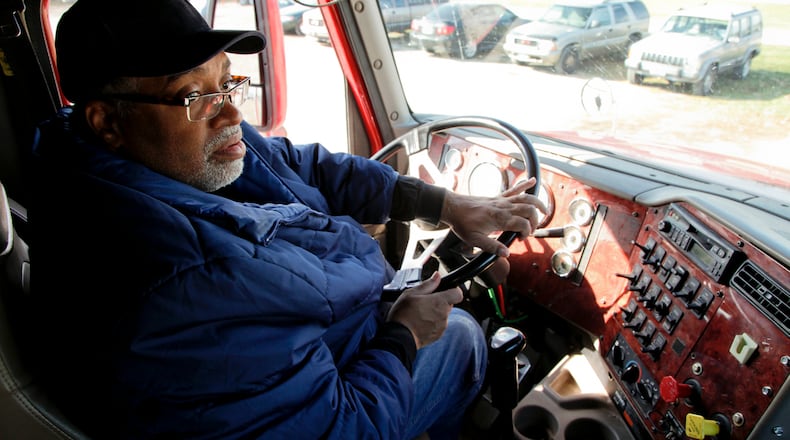Trucking firms are scrambling to attract new drivers and retain their current employees by offering bonuses, pay incentives and better working conditions, some groups said. But life on the road can be a hard sell.
"Many of our members say they've got trucks, they've got freight, but they've got no drivers," said David Bartosic, spokesman with the Ohio Trucking Association.
Some trucking groups, however, argue there is no driver shortage, but rather, the industry’s turnover rate is just extremely high because companies do not offer acceptable pay and work environments.
Between 2010 and 2020, employment opportunities for drivers of heavy and tractor-trailer trucks are expected to grow to 1.93 million jobs from 1.6 million, according to the U.S. Department of Labor’s employment projections.
During that period, the trucking industry is expected to create more jobs than all but seven other occupations including registered nurses (711,900 additional jobs), retail sales workers (706,800 jobs), home health aides (706,300 jobs), personal care aides (607,000 jobs) and office and other clerks (489,500).
3rd fastest job growth
The median annual wage of truck drivers was about $37,770 in 2010, the third highest compensation among the top 10 fastest-growing occupations, according to labor department data. Only registered nurses and post-secondary teachers had higher median annual wages, which were, $64,690 and $45,690, respectively.
But the pay and growing labor demand is not sufficiently increasing the supply of drivers.
The number of people with commercial driver’s licenses dipped last year across the state and in Butler, Clark, Greene, Miami and Montgomery counties, according to data from the Ohio Department of Motor Vehicles. It was the first time in at least a decade that the number of Ohioans with commercial driver’s licenses dropped. Employment in transportation and trucking industries has also fallen this year in Ohio, according to labor department data.
At the current rate, the gap between the number of available tractor-trailer drivers and the U.S. labor demand is expected to widen to 239,000 people by 2022, according to an analysis by the Virginia-based American Trucking Associations.
The shortage of drivers is connected to the impending retirement of many current drivers, said Bartosic, with the Ohio Trucking Association. Freight tonnage also is on the rise as the economy rebounds, increasing the need for additional drivers, he said. Some drivers are leaving the industry in search of easier or better-paying work. And the December 2010 launch of the federal Compliance Safety Accountability program resulted in stricter requirements and regulations on drivers and freight companies.
The American Trucking Associations estimates that about 7 percent of drivers would create scoring problems through the federal safety-compliance program, which means they could lose their jobs or companies may be reluctant to hire them.
In 2011, about 89 percent of the 47,740 people with commercial drivers licenses in the Miami Valley had some sort of traffic violation on their driving records, according to state data. The program seeks to identify and filter out dangerous drivers and trucking companies.
Truck drivers also work long hours and the job can be physically demanding. Truckers often have to be away from their homes for long periods of time.
But the pay is decent, and some drivers can earn between $40,000 to $60,000 if they stick with the job, said Donald Banks, training manager of the Ohio Business College Truck Driving Academy in Madison Twp. in Butler County.
Drivers get to see the country, and the demands of the job are getting easier because of new regulations that limit their hours and guarantee time off, he said. Companies also are improving their work conditions in order to attract and retain employees, and sometimes they provide signing bonuses, raises and other incentives to drivers, he said.
“The job’s a lot more regional than it used to be, and it’s a lot more driver friendly, because they used to just throw you the keys and you’d go to work,” he said. “Now we are a regulated industry, and drivers get home more often than they did.”
A new career with high turnover
Banks said trucking jobs often appeal to older workers who need a new career. Many students who enroll in trucking school were laid off from the manufacturing sector, and the average age of enrolled students is about 54 years old, he said.
Many laid off workers are eligible for financial assistance to pay for school through the federal Workforce Investment Act. Part of the appeal of enrolling is that students are basically guaranteed a job if they graduate and pass the state certification test, Banks said.
“Every student who passes the state test has a job lined up through us,” he said.
The job also appeals to former members of the military.
In an attempt to address both the need for drivers and high unemployment among military veterans, federal lawmakers passed new legislation that will allow military service members to transfer commercial driver’s licenses they obtain while stationed in other states.
By law, commercial driver’s licenses procured in other states are non-transferable. The new legislation exempts military members.
But Banks said the industry’s turnover rate is extremely high. He said he is the only person from his graduating class who still works in the field.
Some local trucking firm executives said there is weak demand for drivers, and they have a hard time retaining employees because they cannot offer competitive wages.
The Owner-Operator Independent Drivers Association said there is no trucker shortage, because the Department of Transportation registers more than 40,000 commercial drivers licenses each year. The group has said the real problem is driver turnover, which results from low pay and poor working conditions. The annualized turnover rate of truck drivers at large companies was 106 percent in the second quarter of 2012, according to industry estimates.
Industry experts said trucking firm need to raise wages and improve their operations to attract and retain drivers.
LeRoy Strickland, 50, of Dayton, graduated from the Ohio Business College Trucking Driving Academy this summer after serving 30 years in the military.
Strickland said he had several offers from trucking companies when he graduated, and he accepted a position with Maverick Transportation because they came highly recommended, and he was impressed with their professionalism.
“It wasn’t about the money for me, it was about the reputation of the company,” he said. “They have an excellent safety record and the maintenance on their trucks is outstanding.”
Strickland said he loves the job, but admits being away from home for long periods can be tough.
_____________________________________________________________
| TRUCKERS IN OHIO | |||
| Number of residents with commercial driver's licenses | |||
| 2011 | 2010 | ||
| Butler | 10,450 | 10,511 | |
| Champaign | 2,141 | 2,141 | |
| Clark | 5,815 | 5,820 | |
| Greene | 4,229 | 4,260 | |
| Miami | 4,275 | 4,329 | |
| Montgomery | 14,297 | 14,395 | |
| Warren | 5,526 | 5,500 | |
| Ohio | 389,969 | 390,895 | |
| SOURCE: Ohio Bureau of Motor Vehicles | |||
| Projected employment growth for heavy and tractor-trailer truck drivers | |||
| 2010 | 2020 | ||
| U.S. | 1.6 million | 1.93 million | |
About the Author

